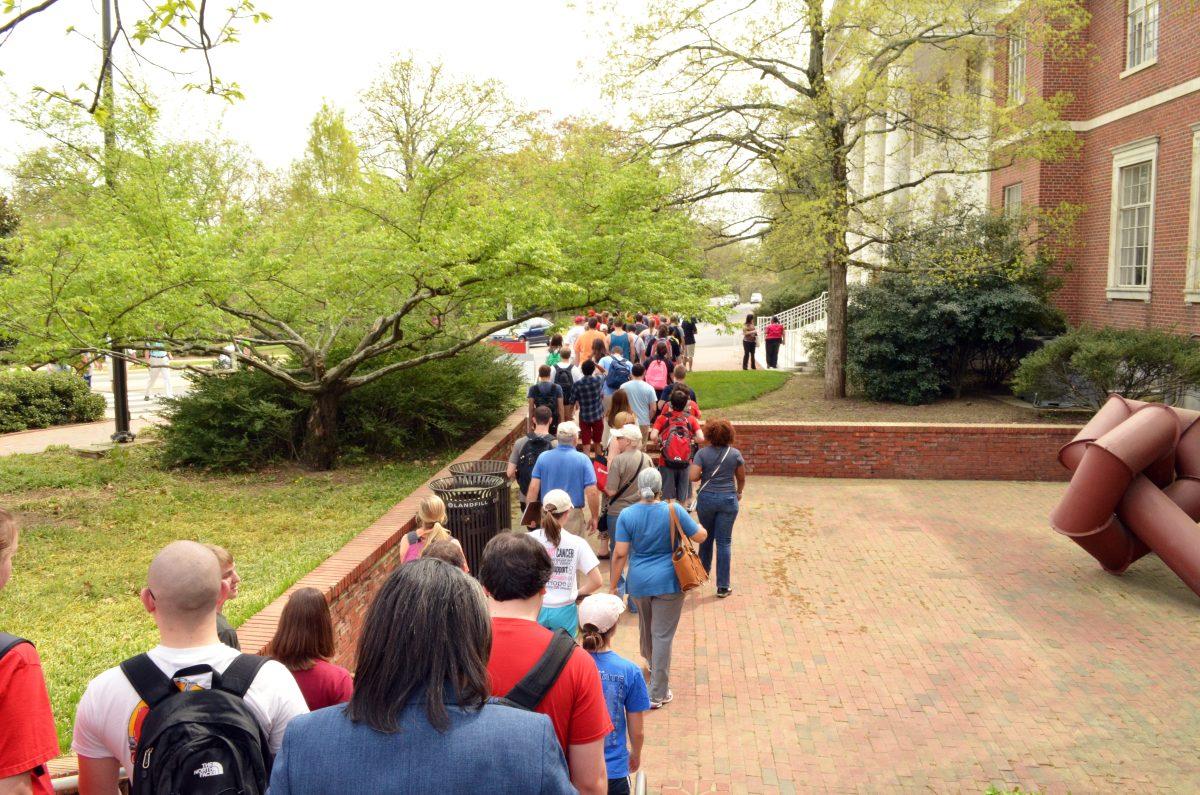
Merari Valencia
NC State students follow Program Coordinator of the African American Cultural Office, Toni Thorpe and Associate History Professor, Walter Jackson on the Red, White, and Black March. A tour that features historial sites that contribute to the de-segregation of NC State. Photo by Merari Valencia
Students engaged with the historical roots of their campus through the Red, White and Black Walking Tour Thursday afternoon.
The tour gave students a chance to capture a glimpse of African American influence on N.C. State’s campus. Created in 2011, the tour is held every semester, typically in November and April.
The tour started at the University’s oldest building, Holiday Hall, and ended in Witherspoon Student Center with a reflection. Walter Jackson, associate professor of history, and Toni Thorpe, program coordinator of the African American Cultural Center, led the tour.
Fred Millhiser, an alumnus who studied at N.C. State in the early 1960s, followed along the tour and spoke to the group at the conclusion of the tour. Millhiser helped desegregate Hillsborough Street when he was a student.
Jackson said he was impressed by Millhiser’s actions as a student.
“I’m from the South, and I know it took some nerve to do that,” said Jackson.
Millhiser said it was interesting to see a bigger picture, besides what he learned when he was a student. “I just had a little sliver of exposure and involvement, and it is nice to get grander view and I really appreciated it.”
Thorpe said the tour is one of her favorite aspects of working at the African American Cultural Center, as she is able to witness the reactions of students. “My favorite part of the tour is those ah-ha moments, when you see students go ‘ah, cool’ or you see them really stopping and what I precede that they are thinking about what other people went through,” Thorpe said.
Elizabeth Eastep, a senior in agricultural studies, said an ah-ha moment made her think about what she and others could do today to prevent discrimination. A story was told about people moving out of their dorms, because one roommate didn’t like the other race. “That thing still happens today,” Eastep said. “So how can we, as a student body, still make people, no matter what their color, culture or background, feel welcomed?”
Eastep said she enjoyed listening about the drive the African American students had to get a college degree. “[I liked] hearing personal stories and courageous people that decided they were going to pursue higher education no matter what the standards were.”
The tour stopped at various places on campus, like Brook Hall, Thompson Theater and the brick sidewalk with Greek letters of African American fraternities and sororities.
Brooks Hall was the first African American Cultural Center before it burned down. Zuqorah Williamson, a senior in psychology, said it was her favorite stop on the tour because of the center’s influence on the University now.
The West Dunn Building, though it wasn’t on the tour, was addressed, which was the previous house of the African American Cultural Center. It was called the “sweatbox” and “the ghetto.” These negative connotations were the launching point for Witherspoon, according to Thorpe.
Jackson said he enjoys when people like Millhiser help fill the gaps of his knowledge about the civil rights movement on campus. “It was just a wonderful serendipity that Fred Millhiser turned up, because what I know about this subject comes from my student’s research papers that they have done in the archives and there are a lot of patches that I don’t know about.”
Williamson said the tour was eye opening and made her think about the progress the University has made and where it stands today. “I feel like a lot of times we live in now and not appreciate history, so just knowing that a lot of people paved the way for me to be here today.”
Thorpe said in the future she hopes Walter Holmes and Edward Carson, the first African Americans admitted to N.C. State in 1956, will join the tour and share their own experiences. Thorpe also said she would like a panel of various people from every decade that helped desegregate the University and created equality on campus.